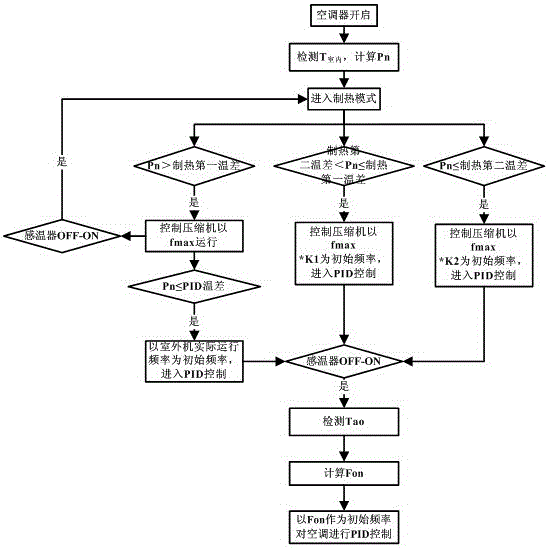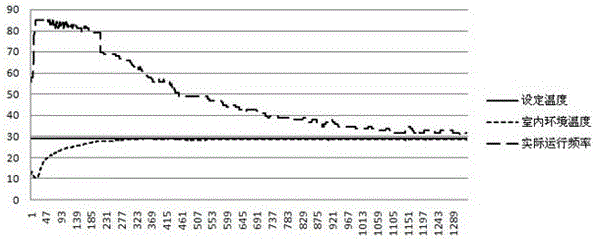A method for controlling the frequency of an air conditioner compressor
An air-conditioning compressor, frequency control technology, applied in the control input involving air characteristics, space heating and ventilation control input, heating and ventilation control systems, etc., can solve the problems of complex control, inaccurate frequency control, etc. Good experience, ensure stable operation, and the effect of stable air conditioning operation
- Summary
- Abstract
- Description
- Claims
- Application Information
AI Technical Summary
Problems solved by technology
Method used
Image
Examples
specific Embodiment 1
[0044] Such as figure 1 As shown, this embodiment takes the cooling mode as an example to illustrate the specific implementation of the present invention. The entry into the cooling mode mentioned in this embodiment includes the first power-on to enter the cooling mode, the mode switching to enter the cooling mode, and the shutdown and restart to enter the cooling mode. mode etc.
[0045] After the air conditioner is turned on, the air conditioner detects the indoor temperature T 室内 , since in the PID control process, the calculation accuracy is 0.1 degree, therefore, let Pn=(T 室内 -T 设定 )*10.
[0046] When entering cooling mode for the first time, compare Pn with the cooling first temperature difference and the cooling second temperature difference:
[0047] If P n>The first temperature difference of refrigeration, control the compressor to run at the highest frequency fmax; during the operation, the air conditioner detects T in real time 室内 , and get P n , if P n ≤The...
specific Embodiment 2
[0081] Such as figure 2 As shown, this embodiment takes the heating mode as an example to illustrate the specific implementation of the present invention. The entry into the heating mode mentioned in this embodiment includes the first power-on to enter the heating mode, mode switching to enter the heating mode, and shutdown Then turn it on and enter the heating mode.
[0082] After the air conditioner is turned on, the air conditioner detects the indoor temperature T 室内 , since in the PID control process, the calculation accuracy is 0.1 degree, therefore, let P n =(T 设定 -T 室内 )*10, where, T 设定 = Manually set temperature + set temperature correction value.
[0083] When entering heating mode for the first time, set P n Compared with heating first temperature difference and heating second temperature difference:
[0084] If P n >The first temperature difference of heating, the compressor is controlled to run at the highest frequency fmax; during the operation, the air c...
specific Embodiment 3
[0102] Such as Image 6 As shown, this embodiment takes the dehumidification mode as an example to illustrate the specific implementation of the present invention. The entry into the dehumidification mode mentioned in this embodiment includes the first power-on to enter the dehumidification mode, the mode switching to enter the dehumidification mode, and the shutdown and restart to enter the dehumidification mode. mode etc.
[0103] After the air conditioner is turned on, the air conditioner detects the indoor temperature T 室内 , since in the PID control process, the calculation accuracy is 0.1 degree, therefore, let P n =(T 室内 -T 设定 )*10.
[0104] When entering the dehumidification mode for the first time, set the P n Compared with the first temperature difference of dehumidification and the second temperature difference of dehumidification:
[0105] If P n>The first temperature difference of dehumidification, control the compressor to run at fmax in dehumidification mo...
PUM
 Login to View More
Login to View More Abstract
Description
Claims
Application Information
 Login to View More
Login to View More - R&D
- Intellectual Property
- Life Sciences
- Materials
- Tech Scout
- Unparalleled Data Quality
- Higher Quality Content
- 60% Fewer Hallucinations
Browse by: Latest US Patents, China's latest patents, Technical Efficacy Thesaurus, Application Domain, Technology Topic, Popular Technical Reports.
© 2025 PatSnap. All rights reserved.Legal|Privacy policy|Modern Slavery Act Transparency Statement|Sitemap|About US| Contact US: help@patsnap.com



